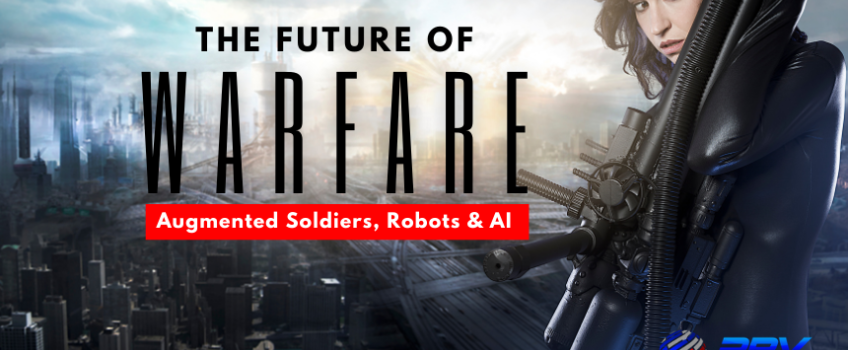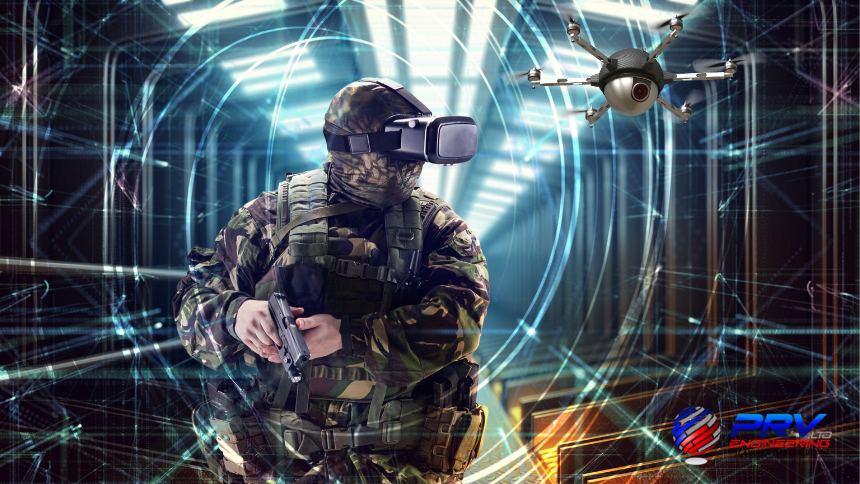
What Would Augmented Soldiers Look Like In The Future?
Since the dawn of man, humans have been waging war against each other for various reasons. As technology advances, so do the tactics and strategies employed by those on and off the battlefield. Looking ahead, the future of warfare could take on a whole new persona as augmented soldiers with advanced cybernetics could very well be on the frontlines.
In a 2020 report by the Department of Homeland Security (DHS), they claim that the biggest threats are no longer nuclear war or conventional warfare. Today, the focus has shifted to cyber warfare, terrorism, foreign influence activities, international cartels, illegal immigration and natural disasters.
In a few decades, if not sooner, the growth of quantum computing, 3D printing, cryptocurrencies, biotechnology and cybernetics could cause an even more drastic shift. The future of warfare could be vastly different with augmented soldiers, robots and drones leading the way.
Augmented Soldiers And Future Technologies
As the world gears up for the future, augmented soldiers seem more likely to come into focus. Fitted with exoskeletons supported by the latest technology, they’ll have some of the most advanced tools at their disposal.
When you think about the future of warfare, you have to consider the blending of technology and psychology. That involves making use of new technologies such as subcutaneous sensor networks, ocular implants, auditory enhancements and direct neural enhancements for brain-to-machine interfacing (BMI).
One could say that augmented soldiers might share some similarities to what we see in the latest computer games, i.e. a HUD (heads-up display) with live data about the environment, fellow squad members and even enemy activity.
The Reality Of Human Machine Interface
Augmented soldiers of the future will have the support of drones and robots with an array of capabilities. Companies like DARPA and Boston Dynamics, among other defence contractors, focus on battlefield machines. Already SPOT the robot dog has made headlines recently but there are many others, including Atlas, MUTT (Multi-Utility Tactical Transport) autonomous unit and the TALON bomb disposal unit.
These robots can perform all sorts of tasks such as transporting supplies, disposing of mines, bombs or IEDs, sentry duty, conduct reconnaissance and provide fire support. These robotic systems will be a more common sight on the battlefield with more sophisticated functionalities whilst being fully autonomous.
As we’ll see in the next section, augmented soldiers may even be able to “control” the supporting units through their HUD, a special device or neural implant.
Exoskeletons And Cyborg Technologies
Robots on the battlefield are undoubtedly a big talking point but they probably won’t be fully functional for some time. So, the next best thing is to equip augmented soldiers with an exoskeleton. Some versions are already in use in factories and more recently for firefighters in China. These type of exoskeletons can give individuals greater strength, endurance and carrying capacity.
According to a recent report by the US Department of Defense (DoD), 2050 will be the year where cyborg soldiers are a regular feature of the US Armed Forces. They also included the following “cyborg technologies” which could have a significant impact.
Ocular Implants
Ocular implants could enhance sight, imaging and general situational awareness. Augmented soldiers can have circuits integrated into the eye to see in other wavelengths such as infrared or night vision. These implants will enable them to easily discern movement, identify targets and project heads-up displays (HUDs) in their field of view.
Augmented Soldiers With Programmed Muscle Control
Future soldiers could also have subcutaneous sensor networks integrated into their bodies. This would enhance muscle control by delivering light pulses, also known as optogenetic stimulation. If they take it a step further and integrate it with an AI-driven situational awareness package, these sensors could offer automated hazard avoidance.
Auditory Enhancements
Another real possibility is replacing or modifying middle-ear bones and cochlea to give soldiers a greater range of hearing and even protection against hearing loss. When combined with ocular and neural implants, auditory enhancements could greatly improve communication and situational awareness. These enhancements may include things like identifying low-intensity sounds, potential hazards, echolocation and localisation.
Direct Neural Enhancement
Grafting computer chips directly into the human brain will enable brain-to-machine interfacing (BMI) and brain-to-brain interactions (BBI). This means soldiers could communicate directly with autonomous systems and other soldiers which will optimise command, control and battlefield operations.
Cybernetic Components For Augmented Soldiers
Cybernetic enhancement can also serve a different purpose with implications for medical care and recovery. Neural implants could address symptoms resulting from brain injuries such as memory loss, dizziness, headaches and nausea among others.
Then other cybernetic implants could help address symptoms related to Post-Traumatic Stress Disorder (PTSD). This is done by breaking the connection between external stimuli and the panic response.
Bionic Prosthetics
Next, we have bionic prosthetics that may also be an option for soldiers who suffer serious, debilitating damage to parts of their bodies. This includes bionic eyes, artificial organs, arms and legs, which will work on sophisticated electrodes merged directly within nerve channels.
These will help restore and potentially enhance mobility and sensory perception while providing sensory feedback. Subcutaneous optogenetic implants could speed up the recovery process where muscles and other soft tissue have been damaged.
Bioprinting and other fields of biotechnology could also be used to print organic tissues on-demand, from skin and organs to muscle tissue and blood vessels. This will greatly improve the survival and recovery rate of soldiers. With this sort of technology, permanent injuries, phantom limb syndrome and perhaps even PTSD could no longer be a concern!
Conclusion
While it’s fascinating to make predictions about augmented soldiers and the future of warfare, things can change in a heartbeat. New technology could quickly replace the old which means adapting once again to a different set of challenges.
We’ll leave you with this quote from AJP Taylor, the famed British military historian, who said: “Nothing is inevitable until it happens.”
For more interesting articles on all things engineering, manufacturing and technology, read our blog and follow us on social media. Use the hashtag #PRVtech to join the conversation.
PRV Engineering works closely with several industries including aerospace, defence, construction and rail among others. We work with basic mild steels to the more exotic Monel, Inconel, Hastelloy and Titanium providing one-off projects, large batch production or Rapid Prototyping.


 Mail:
Mail: 





[…] longer need a computer to perform all the tasks they currently do. For those who don’t want neural implants, there will be smart glasses, smart contact lenses, and wearable […]